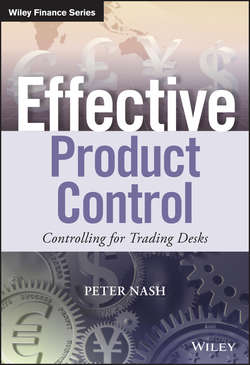Читать книгу Effective Product Control - Nash Peter - Страница 14
На сайте Литреса книга снята с продажи.
Part 1
Working in Product Control
CHAPTER 1
An Introduction to Product Control
The Desk
ОглавлениеA bank maintains separate desks to cover each line of business (FX, rates, credit, etc.). This structure allows the bank to tailor skill sets and focus on the specific markets and financial instruments for each line of business, which benefits the clients and the bank.
For example, the FX desk will only be responsible for pricing client trades and taking discretionary positions in the FX market. These desks will likely be further segregated into sub-desks to facilitate further specialization, such as linear (vanilla) and non-linear (exotic), and time-zone requirements.
Although the financial markets are global in nature, within each of the underlying markets there will be trading start and finish times which the desk's working hours align to. Two of those markets are foreign exchange and the stock markets, which are illustrated in Figures 1.5 and 1.6.
Figure 1.5 The foreign exchange market operating hours
Source: Courtesy, Investing.com www.investing.com
Figure 1.6 World stock market operating hours
Source: Courtesy, Investing.com www.investing.com
Although product control aren't expected to work identical hours to the desk, they need to be primarily the same so the P&L and other deliverables are completed.
The Trading Floor
The desk is located on a trading floor, which is a secure area of the bank and is strictly off limits to anyone who does not need to be there. In some firms, the trading floor seats a few dozen people and in others it seats hundreds of people.
As product control is the face of finance to the front office, to foster a closer working relationship it is important they are within close proximity to the desk. As trading floor space is priced at a premium, product control will be located on a different floor to the traders or in some cases a different building altogether.
The trading floor is a temperately warm area due to the numerous high-spec computers, multiple monitors and large number of data cables connecting the traders to the world. One of the most striking visual features of a trading floor is the proliferation of computer monitors. These screens enable the desk to view all the data it needs to make speedy and sound pricing and risk management decisions. These monitors contain:
• Live market data from suppliers such as Bloomberg and Reuters
• Live risk data from their risk management systems
• Client orders waiting to be filled
• Messaging services which contain information from key stakeholders and external clients – for example:
• Product controllers provide the P&L report which requires approval.
• Market risk provide market risk usage and limit reports which also require approval.
• Middle office provide the day's trade blotter and trade amendments.
Those on the trading floor are connected to each other via dealer boards and turrets (called squawk boxes). These telecommunications devices also connect the traders with their external brokers. To adhere to regulatory requirements and provide evidence in the case of trade disputes, all telecommunication traffic on the trading floor is recorded.
In Figure 1.7 Sir Alex Ferguson is brokering a trade for charity. This desk configuration is similar to what you can expect to see for a trader on a bank's trading floor.
Figure 1.7 Sir Alex Ferguson brokering trades for charity in London
Source: ©PA Images
More recently, the trading floor environment has received a great deal of attention from regulators in multiple jurisdictions around the world. These regulators, for example, the Fed, FCA and APRA/ASIC, commenced reviews of all trader communications, including internal communications with colleagues and external communications with brokers and trading peers, in search of evidence to prove wrongdoing on the part of the trader.
This wrongdoing related mainly to the manipulation of key industry benchmarks such as LIBOR and BBSW, whose consensus yields were purported and in some cases proved, to be set at a level which illegally brought financial gain to the trader (at the expense of others).
These regulatory reviews prompted banks to conduct their own internal reviews of trader conduct, which not only focused on illegalities but also on other aspects of conduct such as trader language, client confidentiality and social activities related to work. The consequences now for traders exhibiting contrary behaviour can be severe and include financial penalties and termination of employment.
The effect of these reviews has been seen by some as bringing the trading floor into the 21st century by creating a more professional working environment, but it has also been viewed as creating a more sterile environment where traders are far more reluctant to “shoot from the hip”. Gordon Gekko and Jordan Belfort need not apply to work in the City these days.
Pressures of Supporting the Desk
The trading floor is a high-pressure environment, which raises the stress levels of traders and has a knock-on effect for product control. This pressure stems from the speedy and significant decisions traders need to make and the significant financial implications of these decisions.
As traders' pay is primarily based upon how much P&L they generate, traders can react badly when they incur trading losses, especially when they are behind budget. As product controllers, we need to be mindful of this, especially when you are the person reporting that loss. It's important not to take a trader's reaction personally.
As trading desks have great expectations placed on them, it is important that product control respond with appropriate urgency to their requests and to potential control issues. Financial markets have a way of inflicting damage on banks, so it's important that control issues and requests are dealt with in a timely manner.
This completes our introduction to product control. The remaining part of this book will examine the changes occurring within product control and introduce the role of product control's primary stakeholders.
